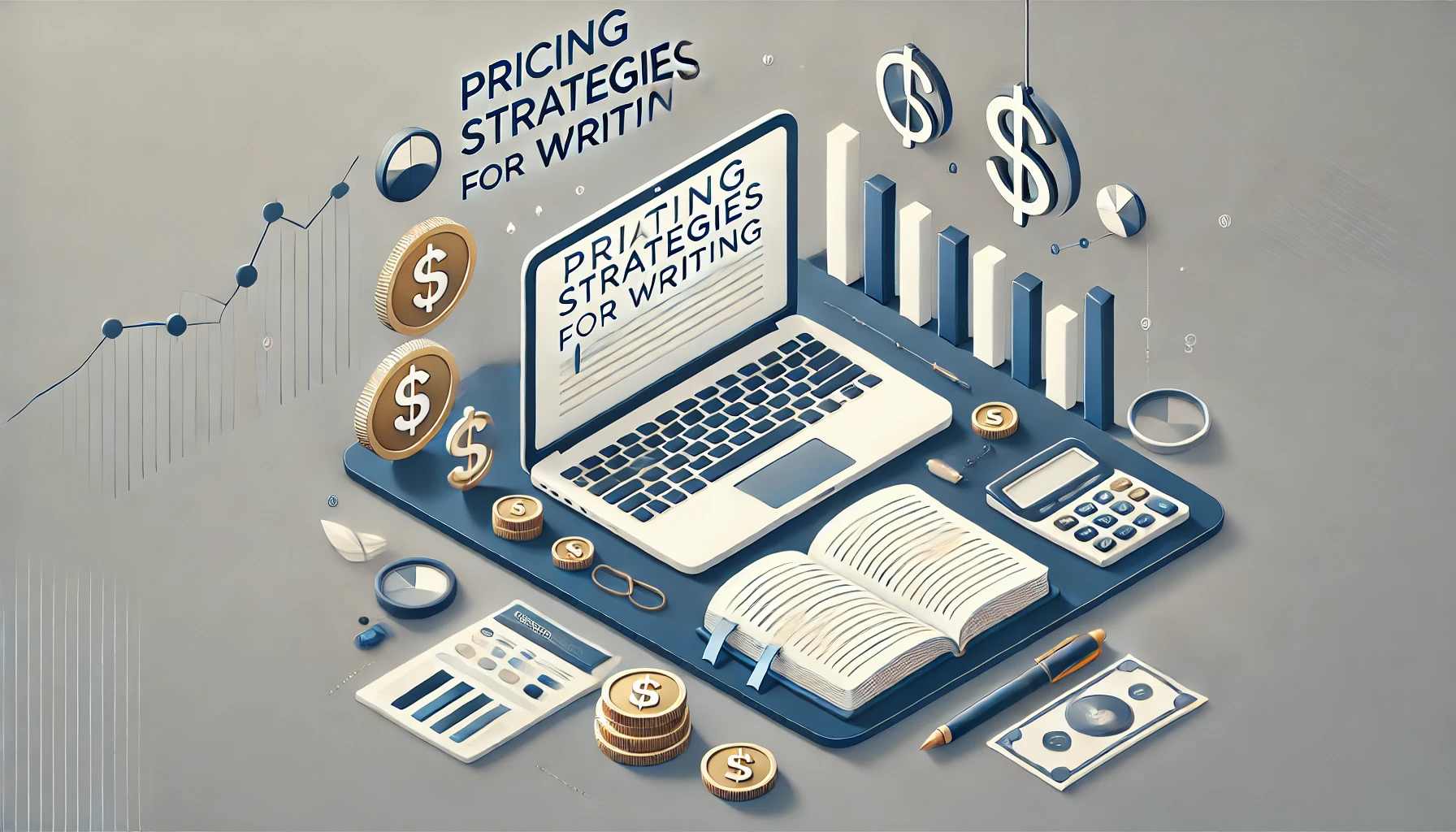As a writer, one of the most challenging tasks you’ll face is figuring out how to set your prices. Whether you’re a freelance writer, content creator, or author, pricing your work correctly is crucial to building a sustainable and profitable career. Underpricing might lead to burnout and dissatisfaction, while overpricing could deter potential clients. In this blog, we will delve into Pricing Strategies for Writing—how to approach them, factors to consider, and ways to ensure you get paid what you’re worth.

Understanding the right pricing model is not only about covering your time and effort but also about matching market expectations. By mastering various Pricing Strategies for Writing, you can position yourself well in a competitive market and establish a sustainable income.
Table of Contents
Why is Pricing Important in Writing?
Pricing in writing isn’t just about making a quick sale. It’s about sustaining a long-term career, ensuring that you can continue to produce quality content while being adequately compensated. Writers often struggle because they fail to recognize the value of their work, leading to inconsistent income and missed opportunities.
Knowing how to price your services strategically can be a game-changer. It defines your market position and helps establish credibility with clients. Additionally, your pricing strategy impacts your reputation, the types of clients you attract, and the workload you can comfortably handle.
Types of Writing Services and How They Affect Pricing
Different writing services require different pricing approaches. Let’s discuss some common types and the best Pricing Strategies for Writing for each:
1. Blog Writing and Article Writing
Blog and article writing are among the most common freelance services. Pricing for these services often depends on factors like word count, complexity, research required, and the target audience.
2. Copywriting and Sales Content
Copywriting is a high-value service, given its impact on a company’s bottom line. Many writers charge premium rates for sales-oriented content, as clients expect a return on investment from persuasive copy.
3. Ghostwriting
Ghostwriting involves writing content that is credited to someone else. The level of confidentiality and quality expected in ghostwriting projects often justifies higher rates.
4. Technical Writing
Technical writing requires specialized knowledge, which usually commands a higher rate. Writers often charge per hour or per project, depending on the depth of technical detail required.
5. Creative Writing and Fiction
Creative writing rates vary widely. Some writers price per word, while others prefer project-based pricing, especially for larger works like novels or screenplays.
Factors Influencing Pricing Strategies for Writing
Several factors influence how you should price your writing services. Below are some of the most significant considerations:
1. Experience and Skill Level
Your experience in the industry and the quality of your writing play a key role in how you price your services. Beginners may need to price lower to attract initial clients, while experienced writers can charge more due to their expertise.
2. Market Demand and Competition
Understanding the current market demand for specific writing services is essential. High-demand services like SEO writing can command higher prices, while highly competitive fields may force you to adjust your rates to stay competitive.
3. Client Budget
Clients come with varying budget levels. Understanding your ideal client and what they can afford will help you set a pricing strategy that aligns with your business goals.
4. Project Scope and Complexity
For more complex projects requiring in-depth research, interviews, or specialized knowledge, higher rates are justified. Project-based pricing can work well for complex tasks, ensuring you’re compensated adequately for your time and expertise.
5. Turnaround Time
Faster delivery times can justify a higher rate. If a client requires a short deadline, you may want to include a “rush fee” to account for the added urgency.
Different Pricing Models in Writing
When discussing Pricing Strategies for Writing, it’s essential to understand the various pricing models you can adopt:
1. Per-Word Pricing
This is a common model for blog posts, articles, and web content. It is transparent and easy for both writers and clients to understand. However, per-word pricing may not reflect the complexity of the work required.
2. Per-Hour Pricing
Charging per hour works well for projects requiring a lot of client interaction, research, or revisions. However, some clients may prefer a fixed price for the entire project to know the costs upfront.
3. Per-Project Pricing
This is ideal for larger projects like white papers, ebooks, or technical manuals. It allows writers to factor in all aspects of the work, including research, writing, and revisions.
4. Monthly Retainer
Retainers provide consistent income and are perfect for ongoing projects like blog management or content marketing. This model is particularly useful for writers who want steady, predictable earnings.
5. Value-Based Pricing
This model involves pricing based on the value your content provides to the client. If your writing will contribute significantly to a client’s business, such as copy that generates leads or sales, you can charge a premium.

Tips for Setting and Negotiating Your Writing Rates
1. Know Your Minimum Acceptable Rate
Determine the lowest rate you’re willing to accept by calculating your expenses, desired profit, and time investment.
2. Research Market Rates
Understanding what others in your niche charge will give you a benchmark for setting your rates. Platforms like Upwork, Fiverr, and freelance forums can provide insights.
3. Build Your Portfolio
A strong portfolio can justify higher rates. Clients are more likely to pay top dollar if they see evidence of your skills and past successes.
4. Offer Packages
Offering packages can simplify the pricing process and attract clients looking for comprehensive solutions.
5. Be Transparent and Professional
Always be upfront about your rates and explain how they reflect the quality and scope of your work. Professionalism in communication often leads to smoother negotiations and better client relationships.
6. Don’t Undervalue Your Skills
Many writers make the mistake of undervaluing their work. Remember, your writing is a skill that brings value to others, and it should be compensated accordingly.
Examples of Successful Pricing Strategies for Writing
1. Case Study: Freelance SEO Writer
A writer specializing in SEO content set a per-word rate of $0.15 after researching industry standards. They also introduced a rush fee of 20% for projects requiring a 24-hour turnaround. This approach allowed them to attract consistent work and justify higher rates for urgent tasks.
2. Case Study: Technical Manual Writer
A technical writer chose a per-project pricing model, charging between $2,000 and $5,000 depending on complexity. This strategy provided clear boundaries and ensured that the client knew the full cost upfront.
3. Case Study: Blog Content Creator
A blog writer used a monthly retainer model to secure regular clients at $1,500 per month for four articles weekly. This guaranteed a steady income and allowed for better long-term planning.
Conclusion
Pricing Strategies for Writing are crucial for any writer looking to make a sustainable living in this field. Whether you’re a novice or a seasoned professional, understanding different pricing models, market dynamics, and your own value will empower you to set rates that reflect the quality and expertise you bring to the table. By choosing the right strategy, you’ll not only attract the right clients but also ensure that your work is valued and respected.
FAQs
What is the best Pricing Strategies for Writing for new writers?
New writers may benefit from per-word pricing or hourly rates to gain initial experience. As you grow, transitioning to value-based or per-project pricing can increase your earnings.
How do I handle clients who ask for lower rates?
Be polite but firm in explaining your rates. If a client cannot meet your minimum rate, it may be best to walk away and focus on clients who value your work.
Should I charge differently for different types of writing?
Yes, the complexity, research required, and value to the client should influence your rates. Sales copy or technical writing usually commands higher fees compared to basic blog posts.
What is value-based pricing?
Value-based pricing is a strategy where you set rates based on the value your work provides to the client. For example, if your writing directly contributes to sales or leads, you can charge a premium.



